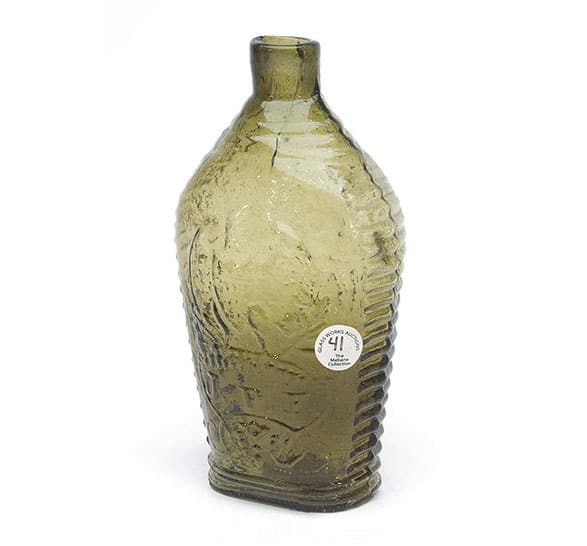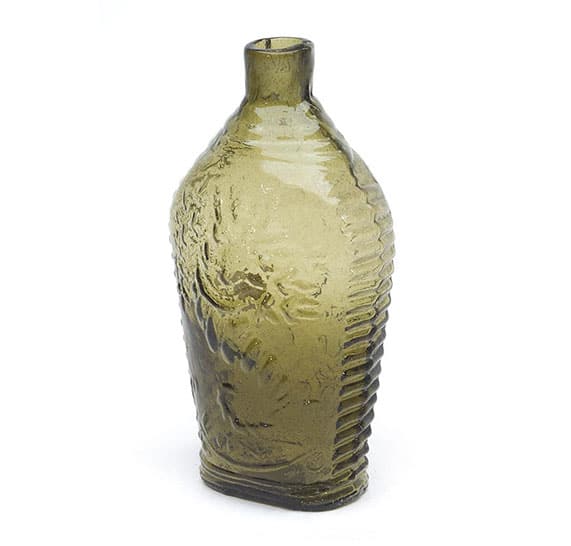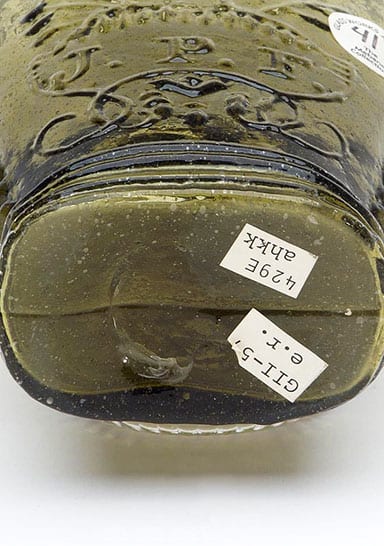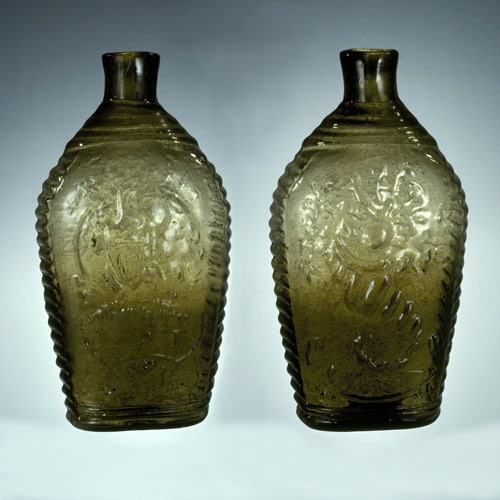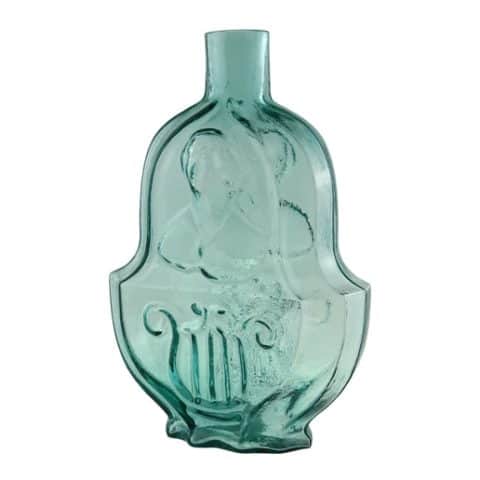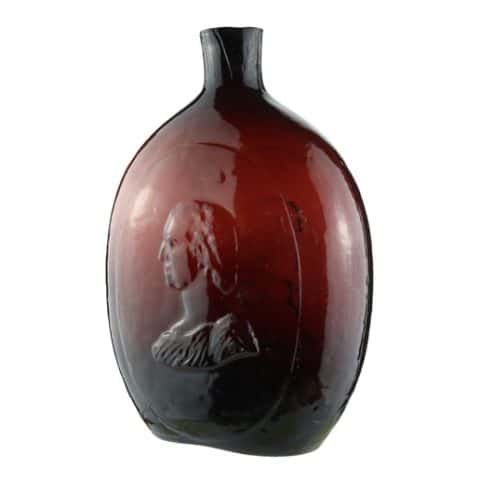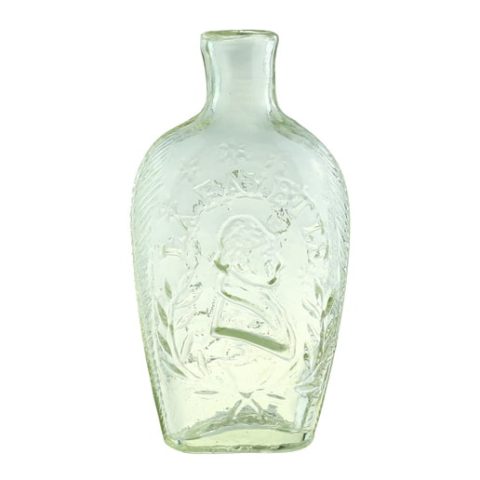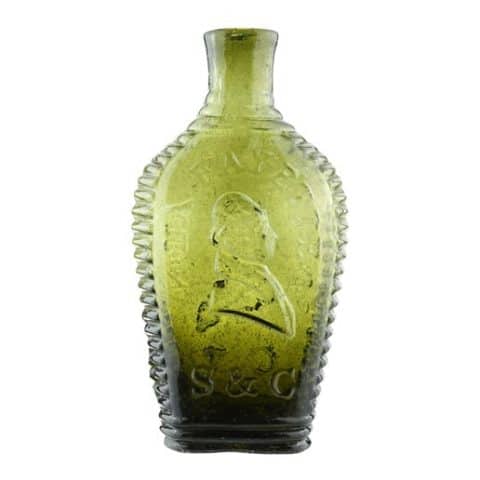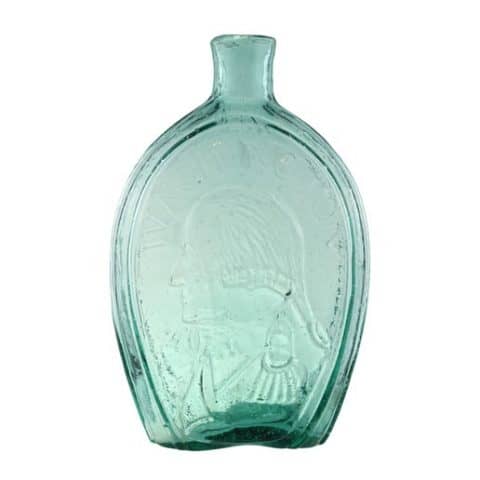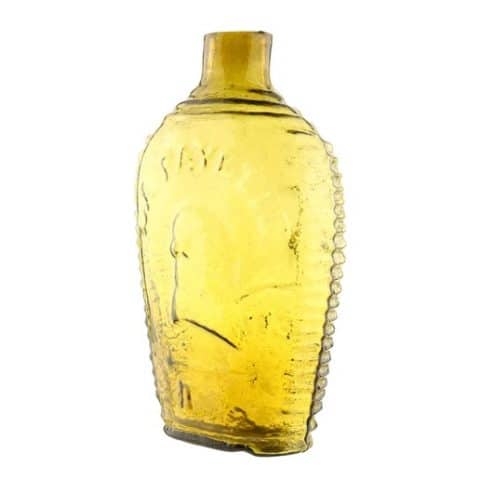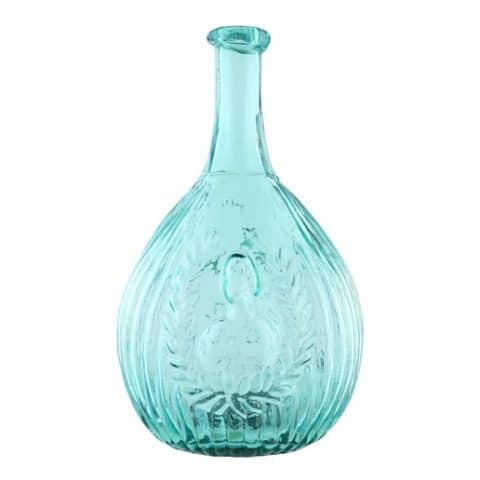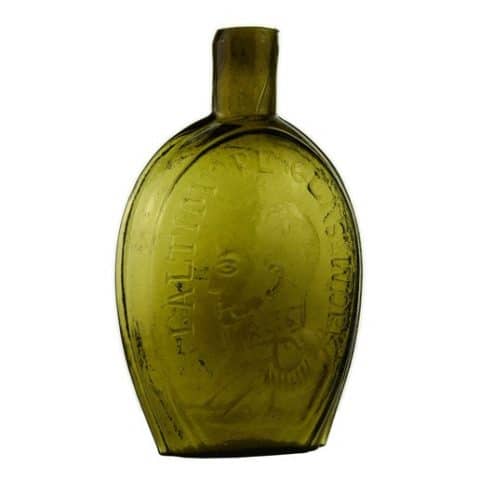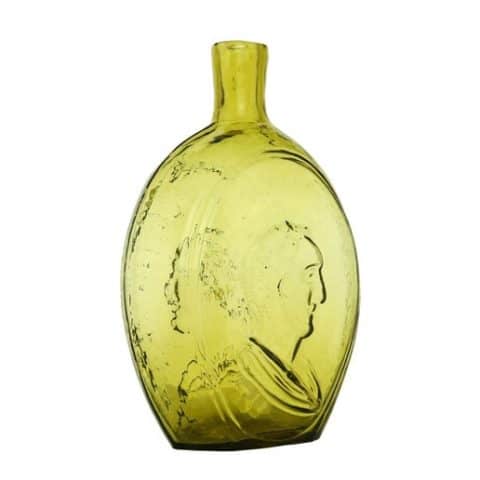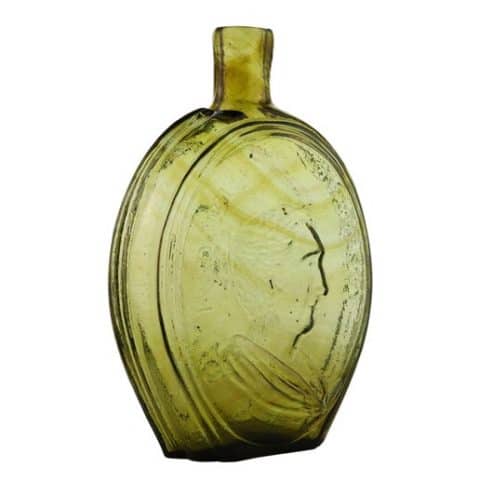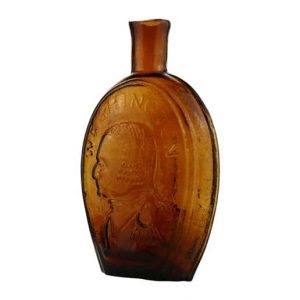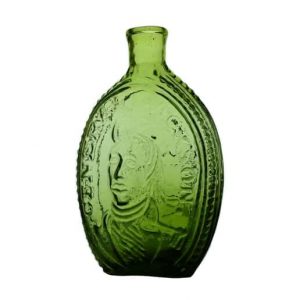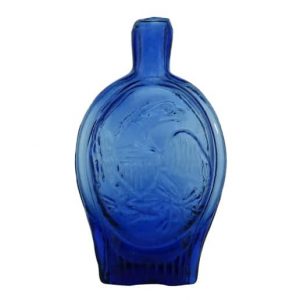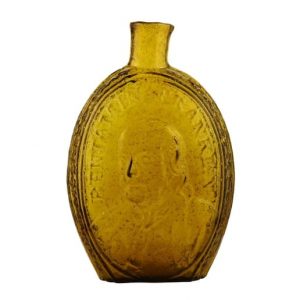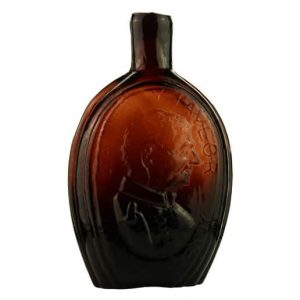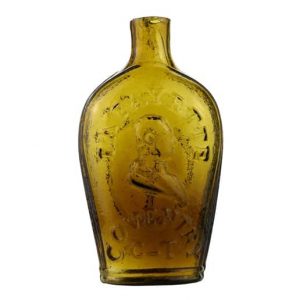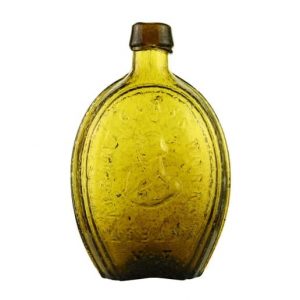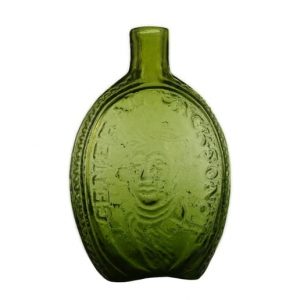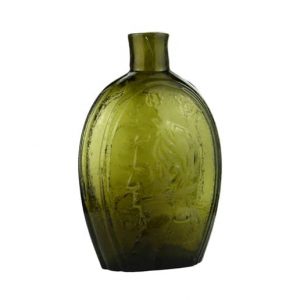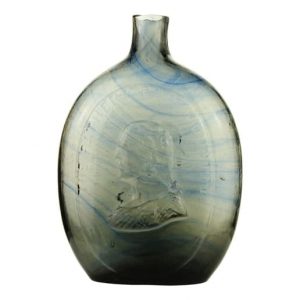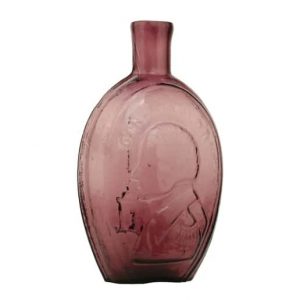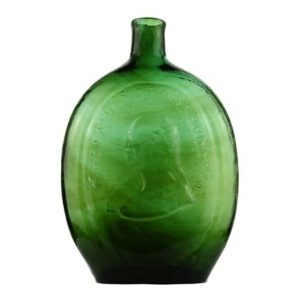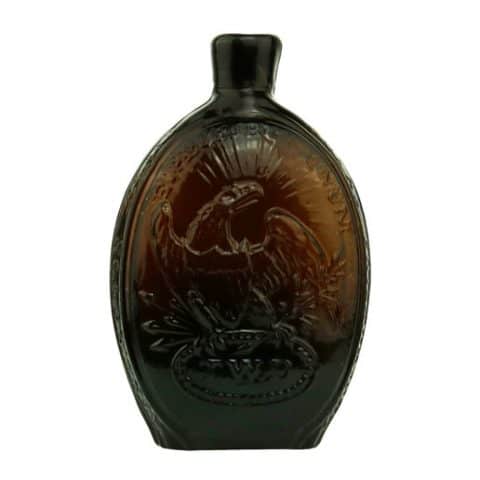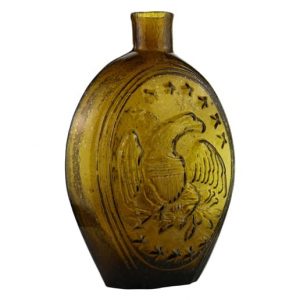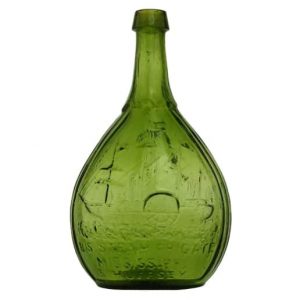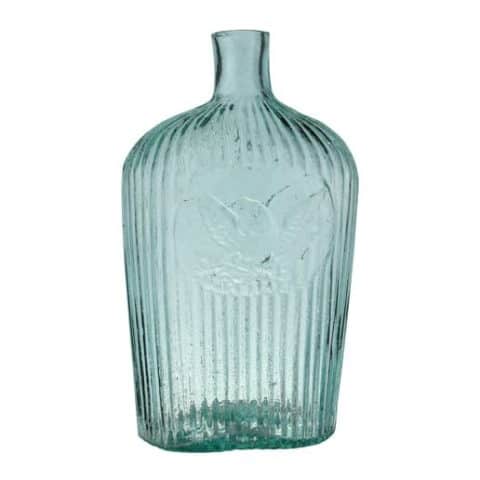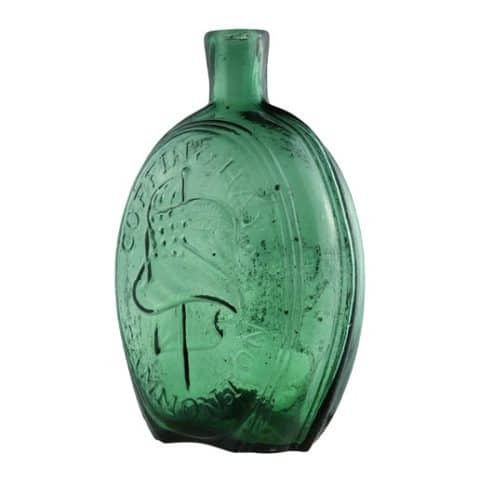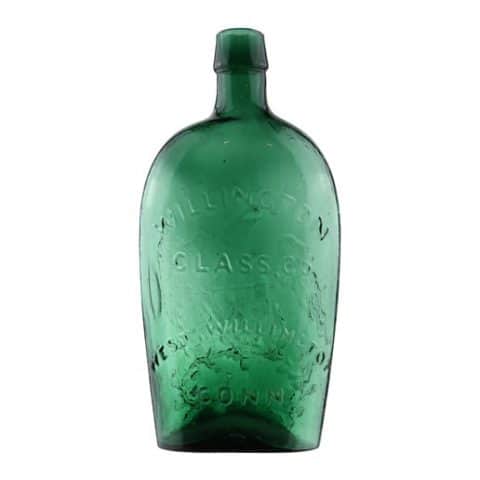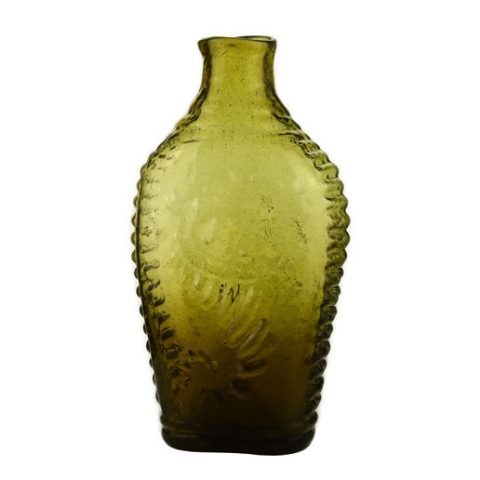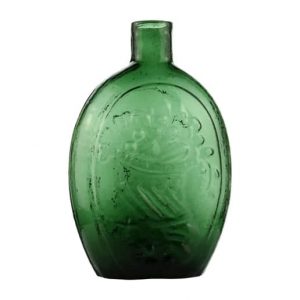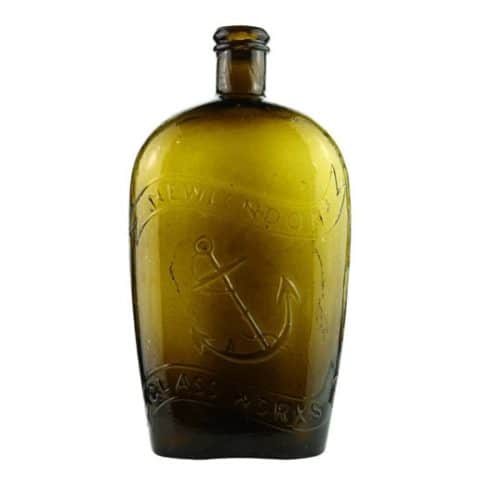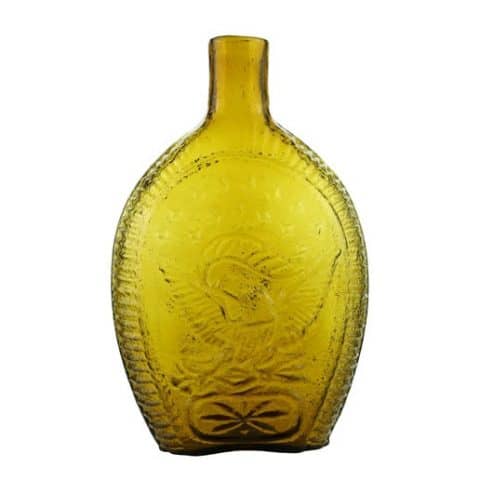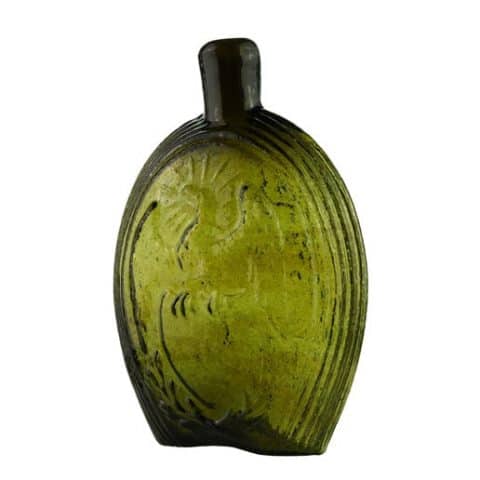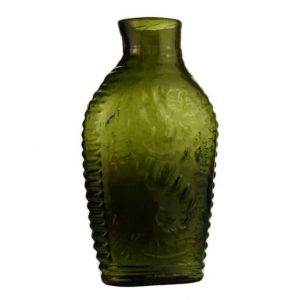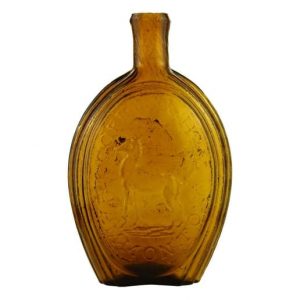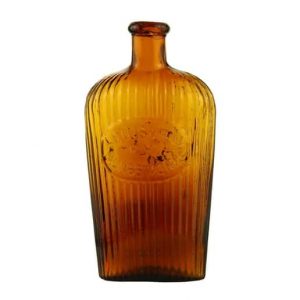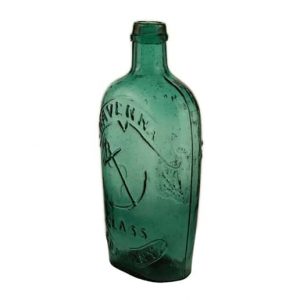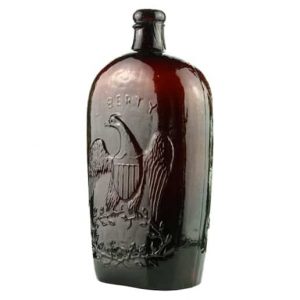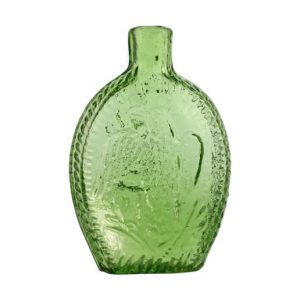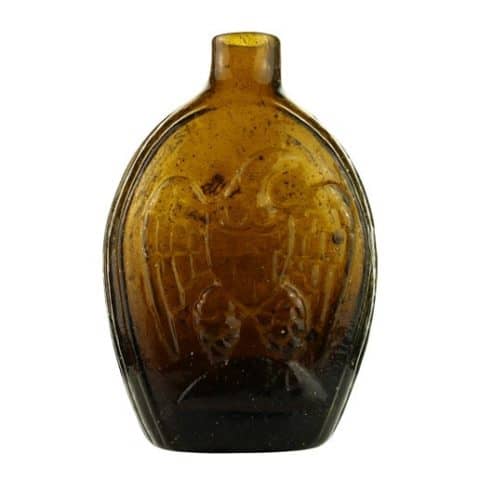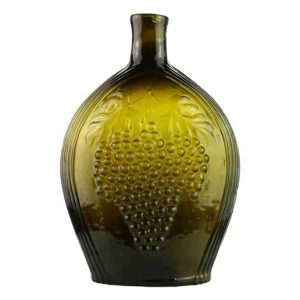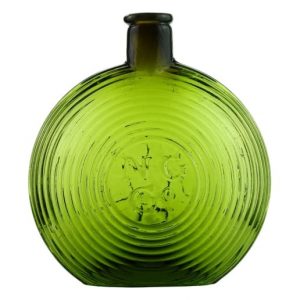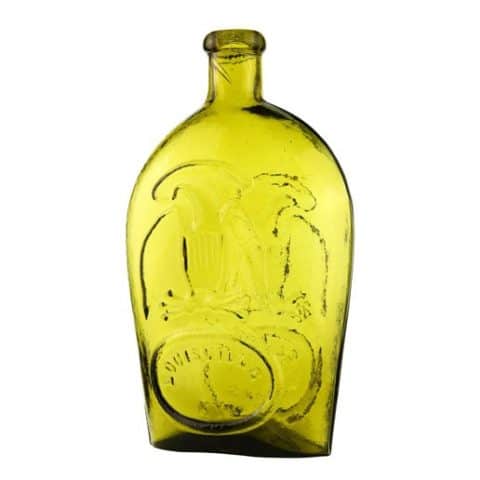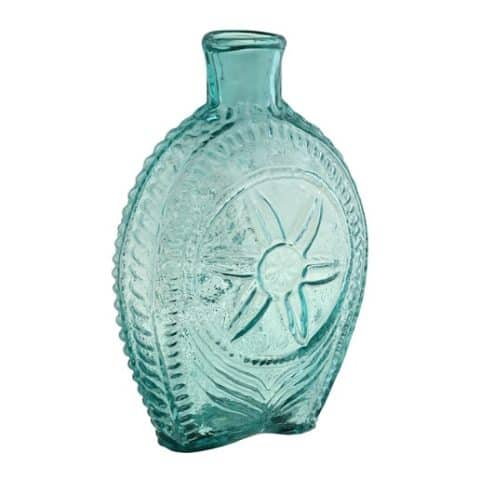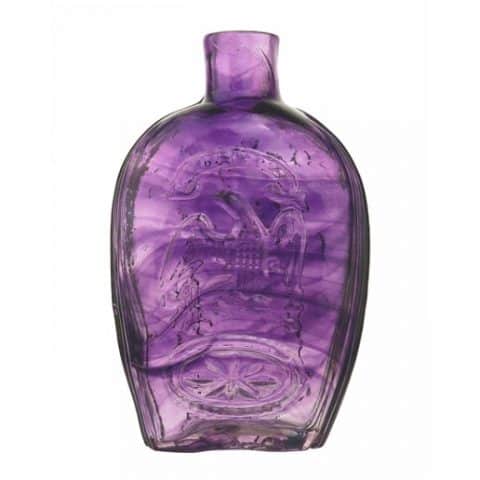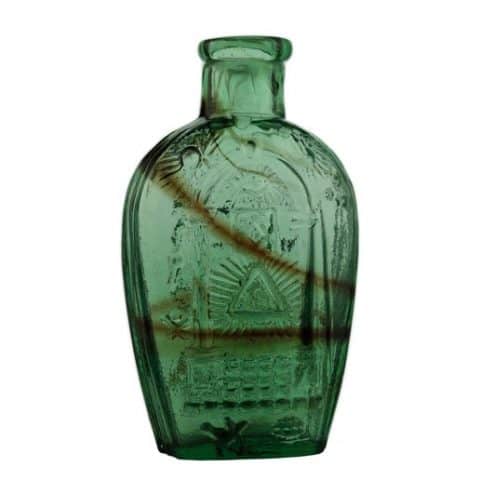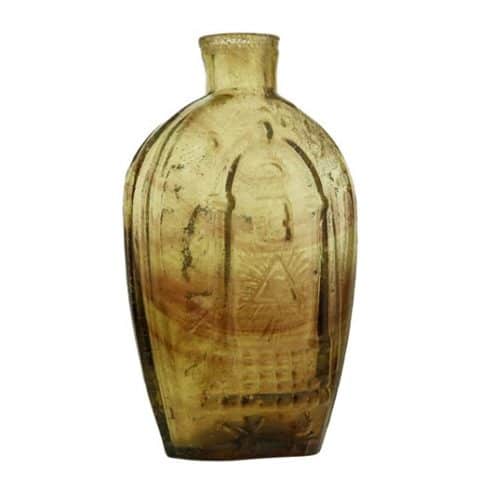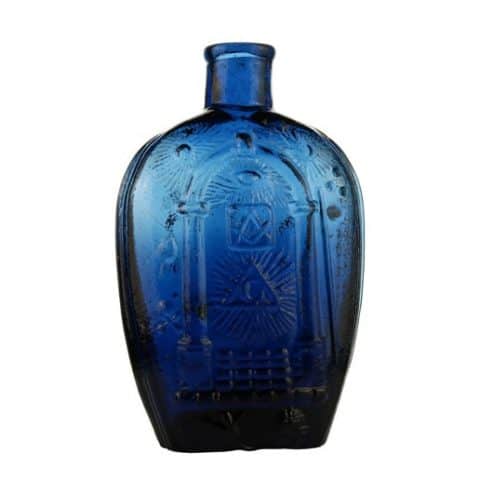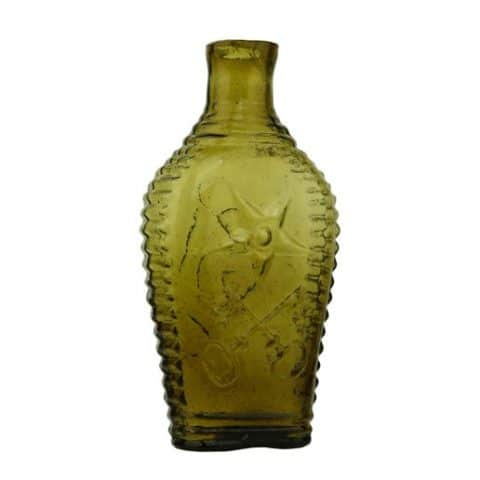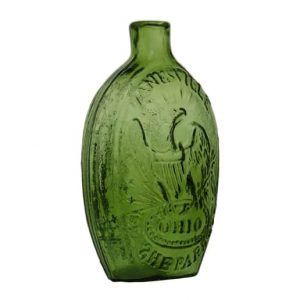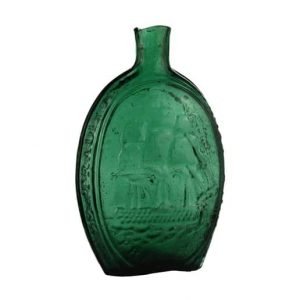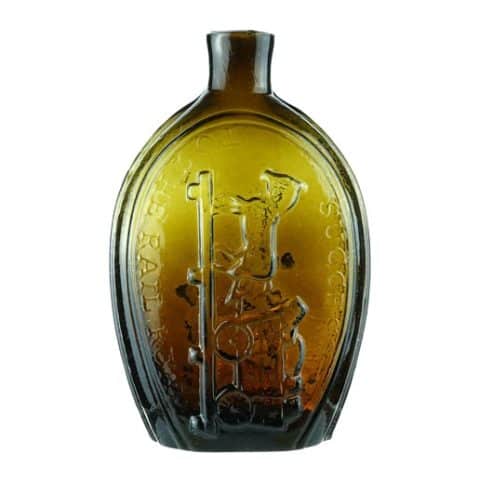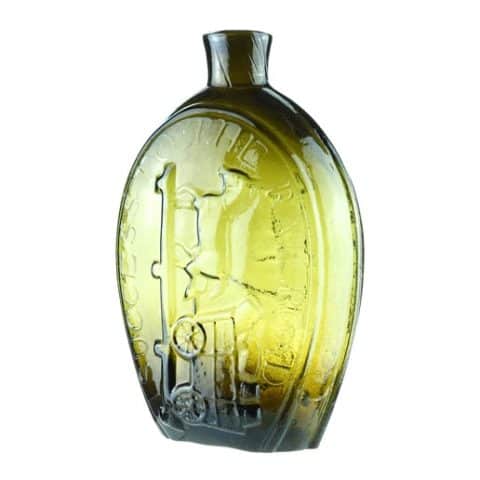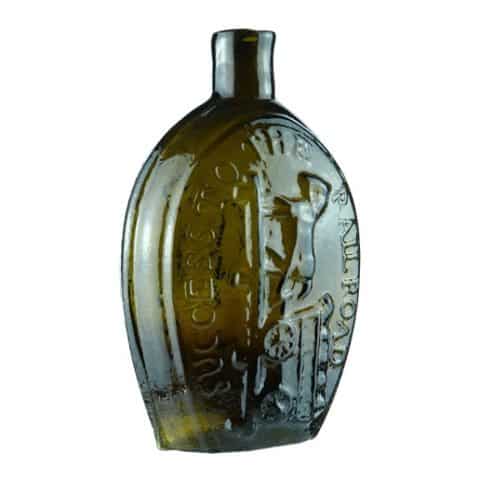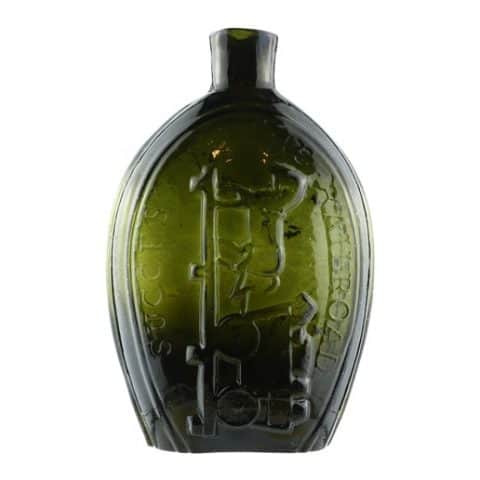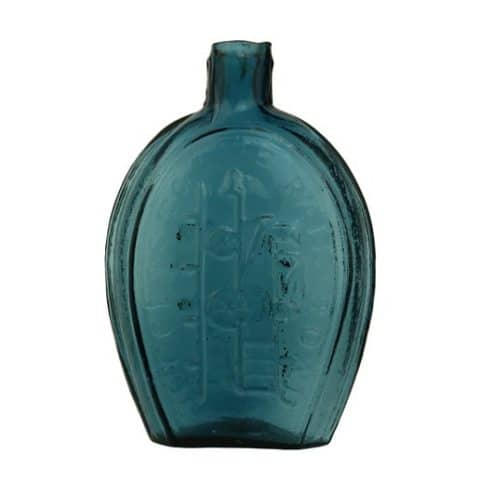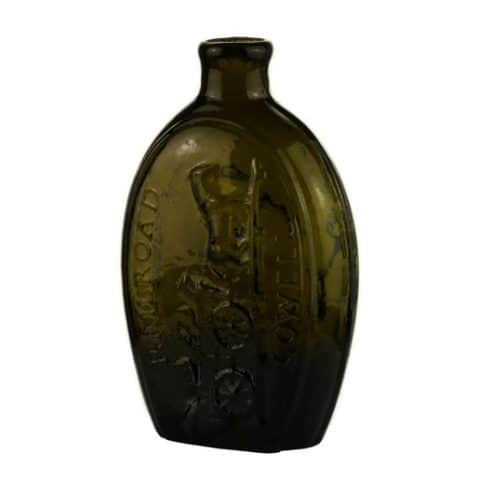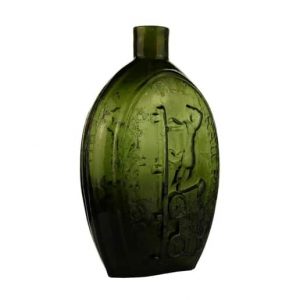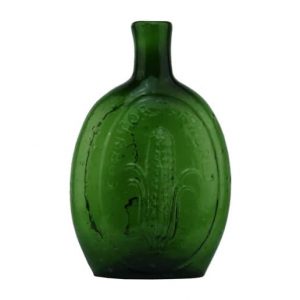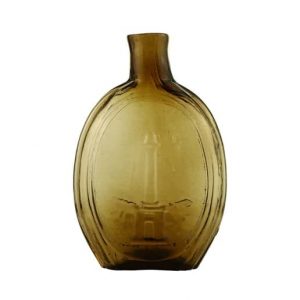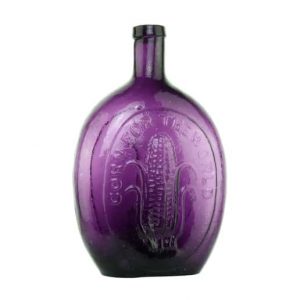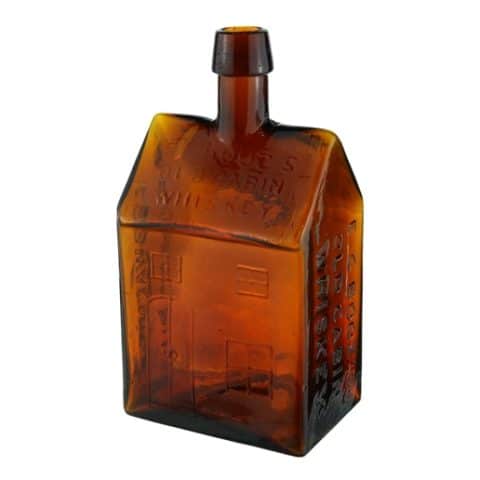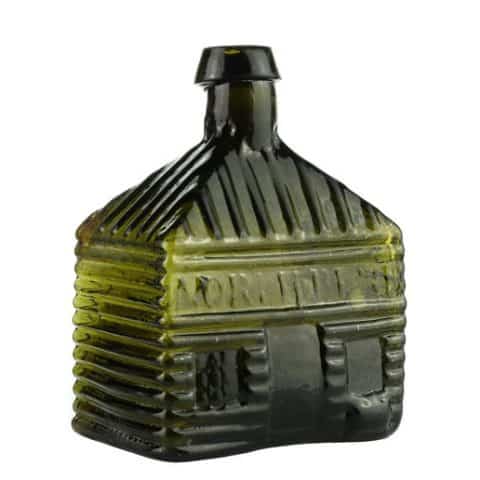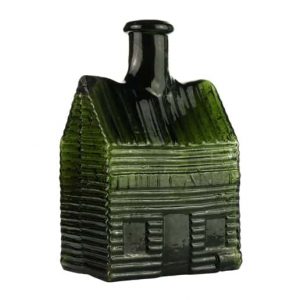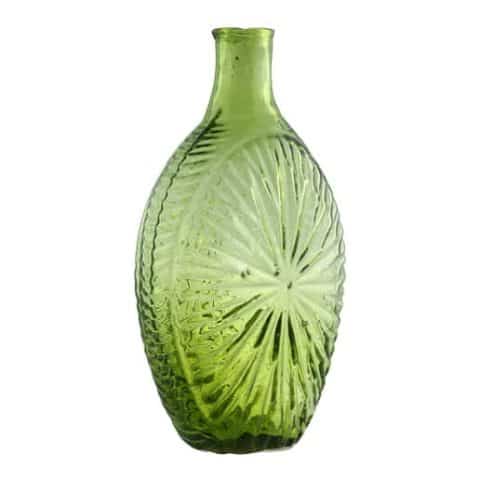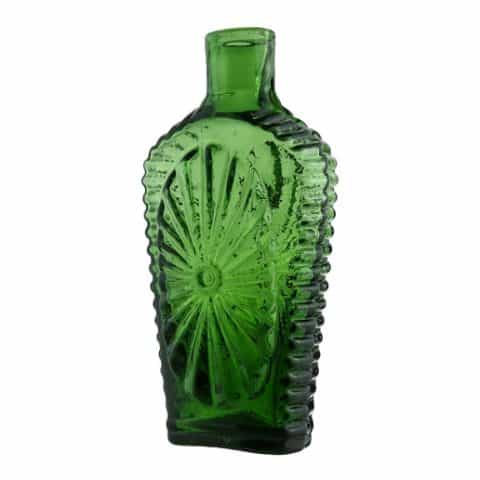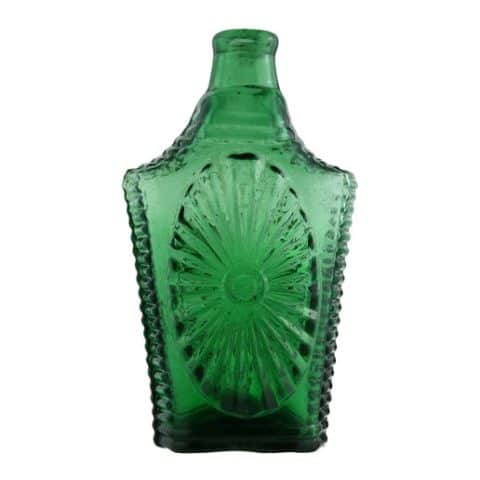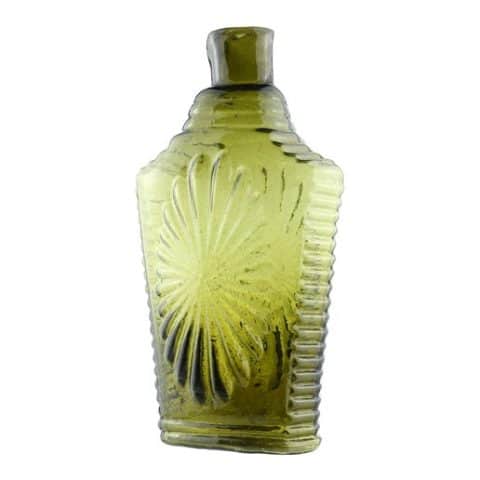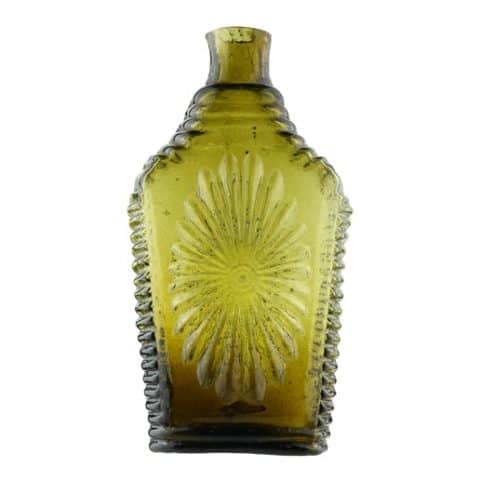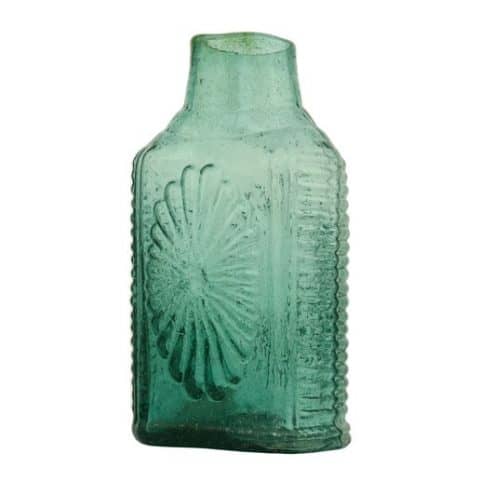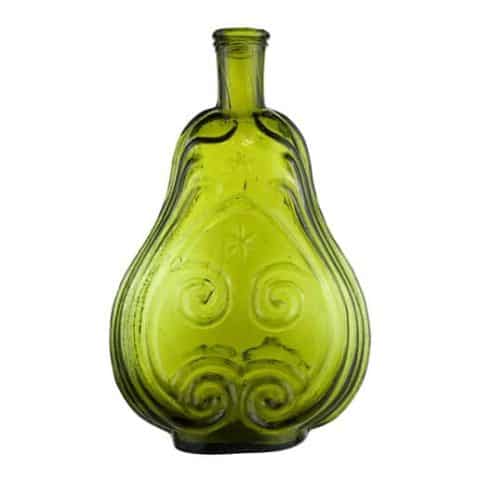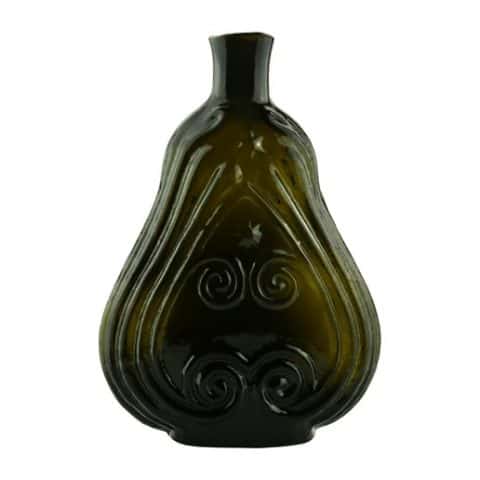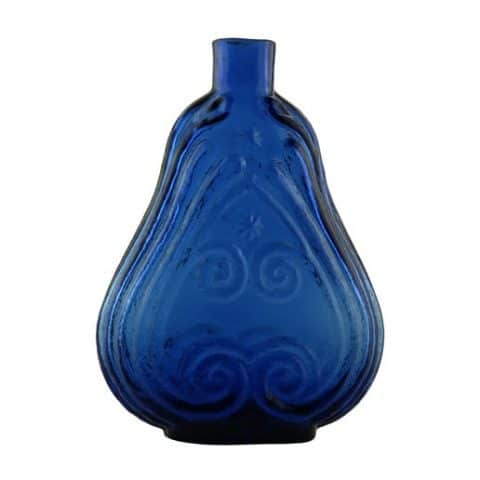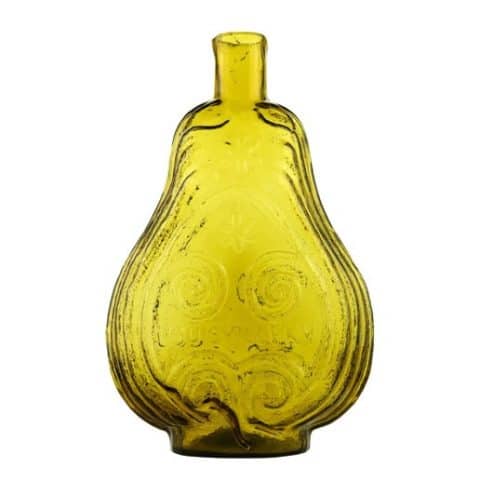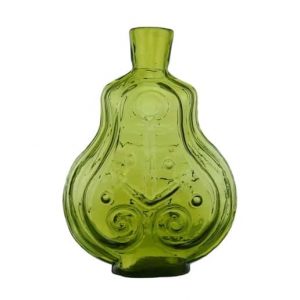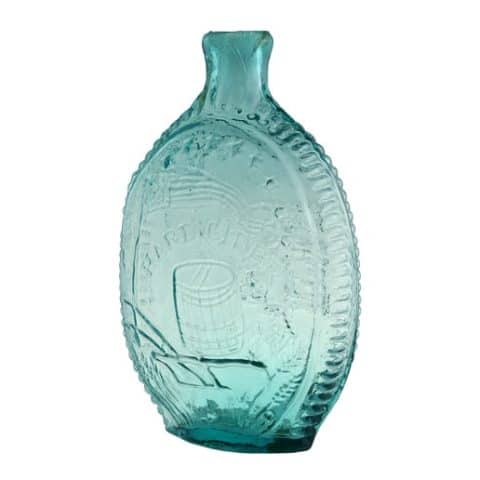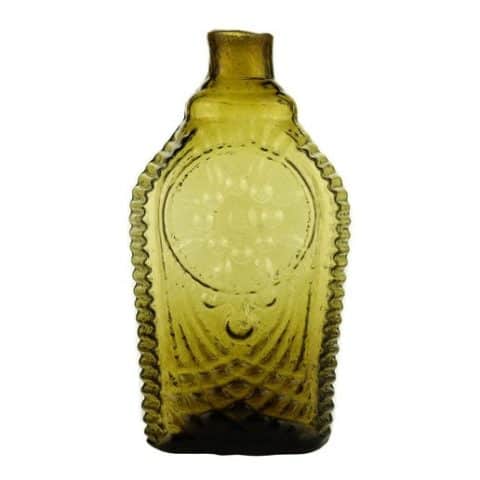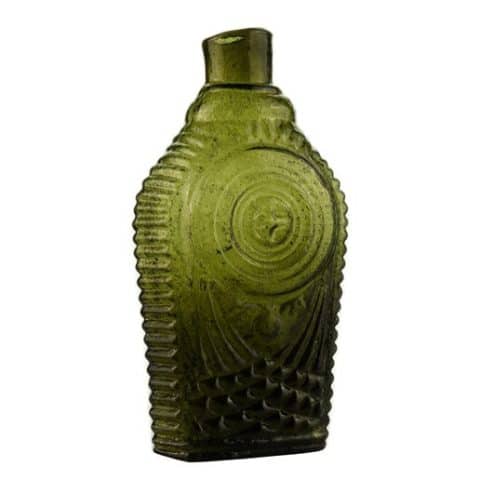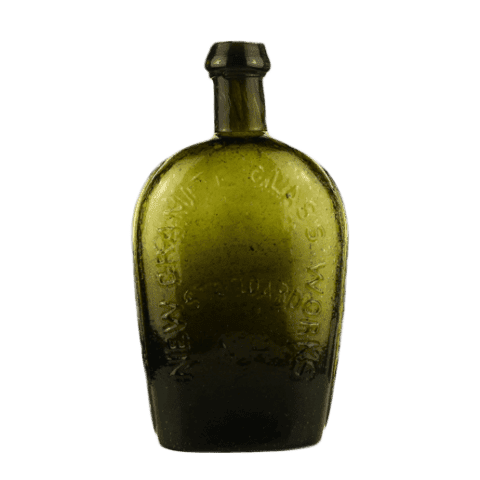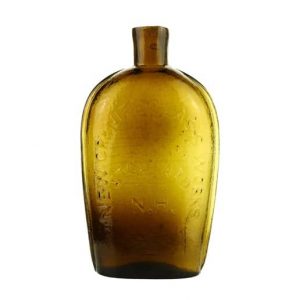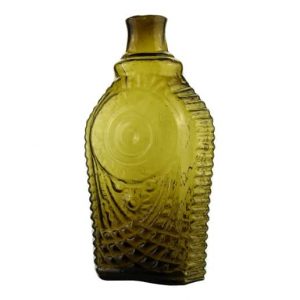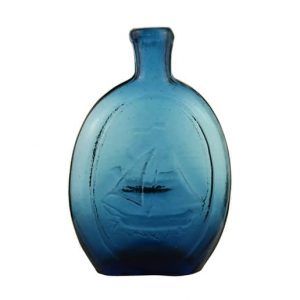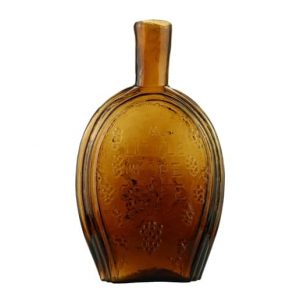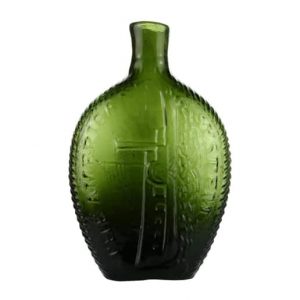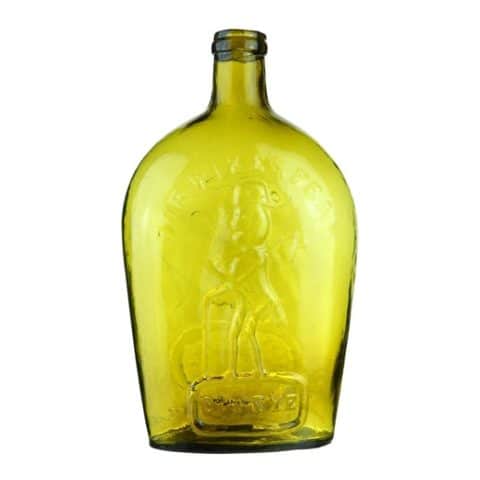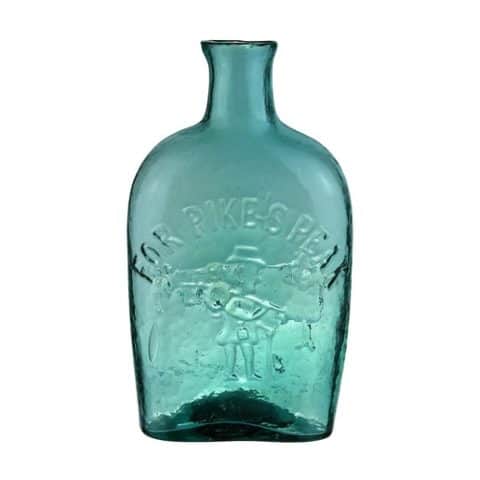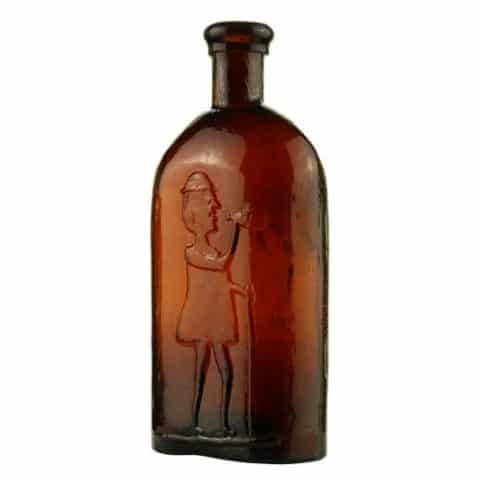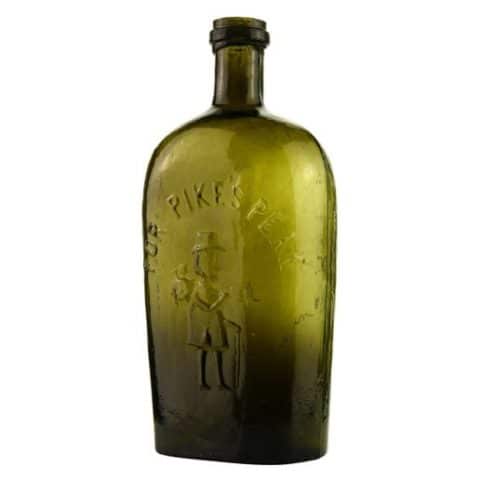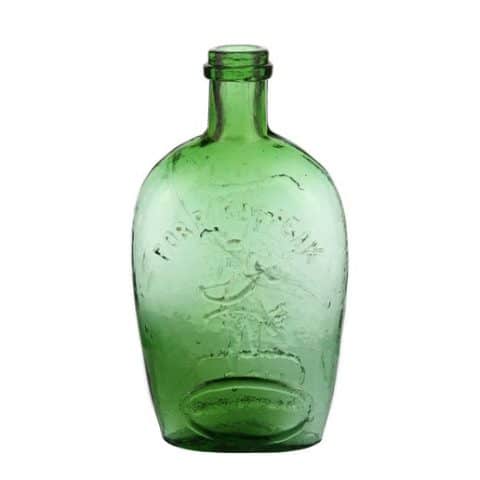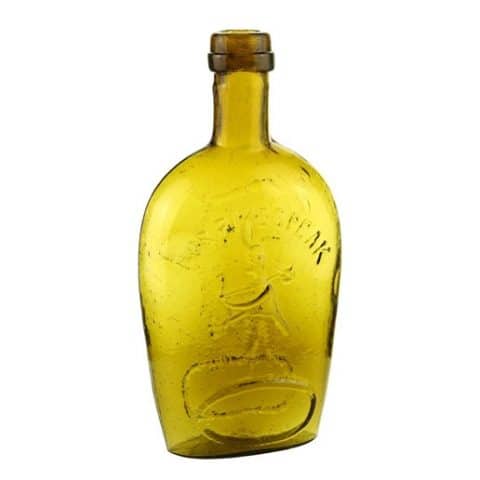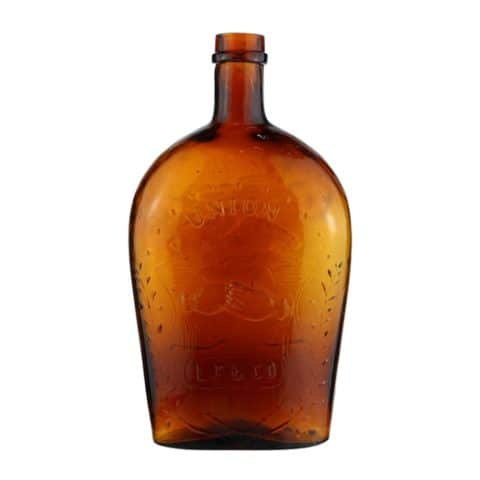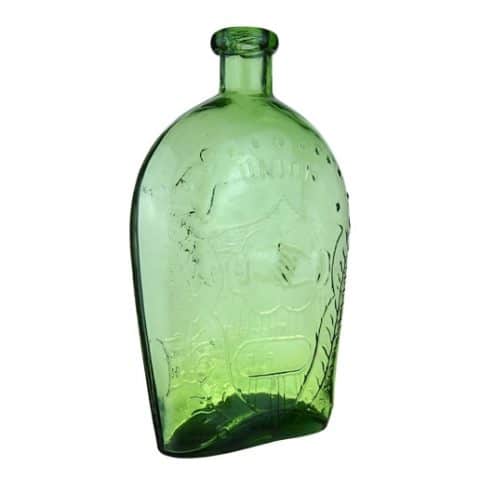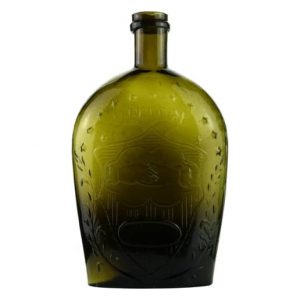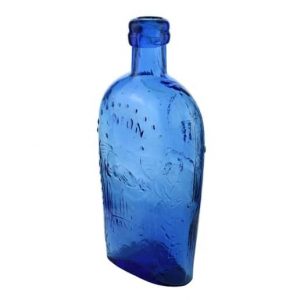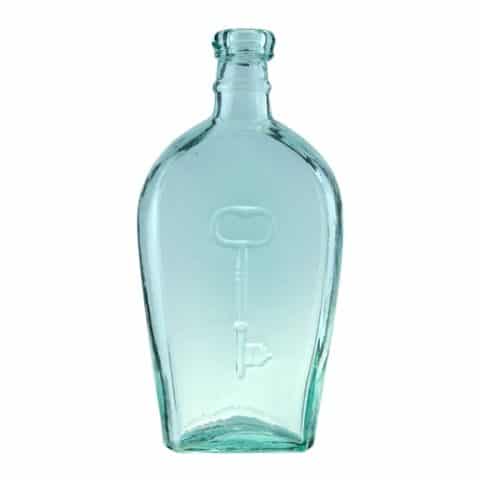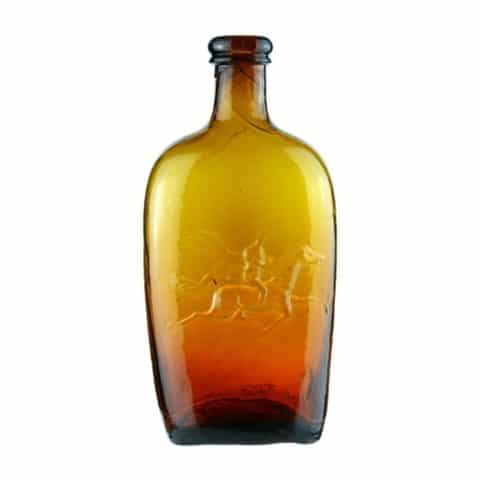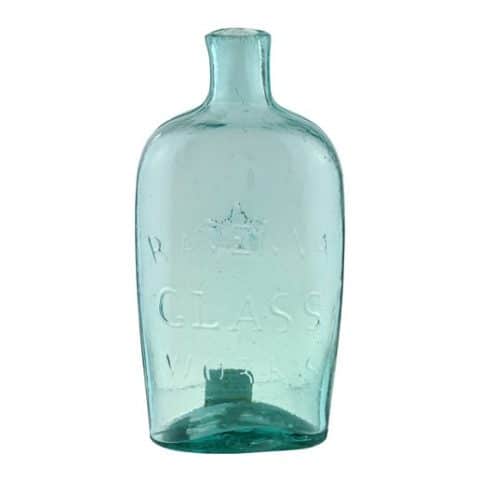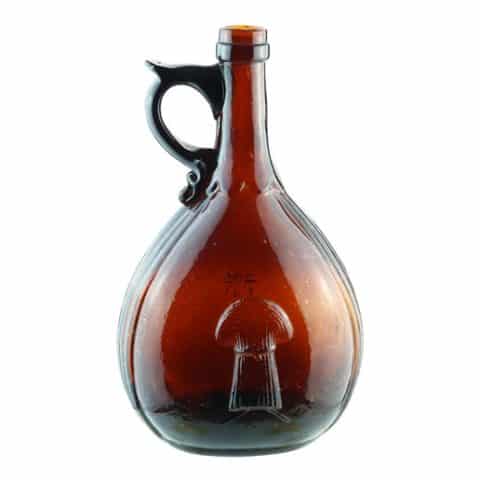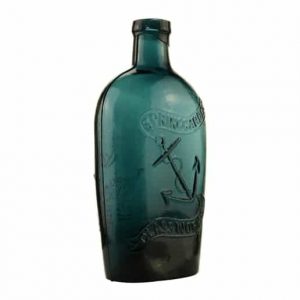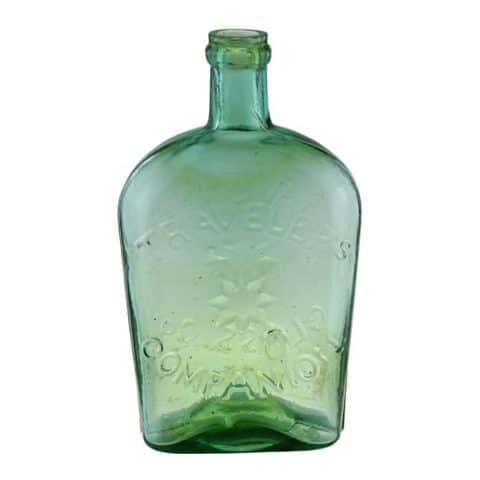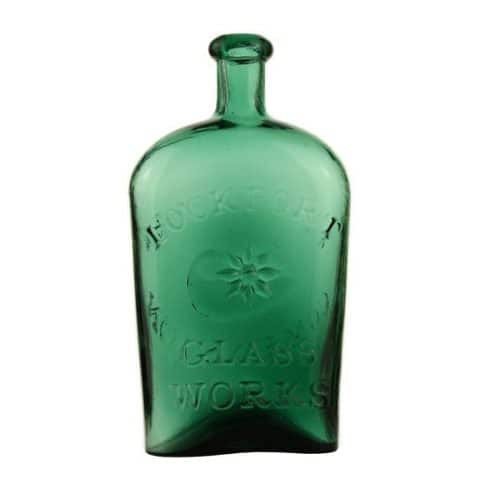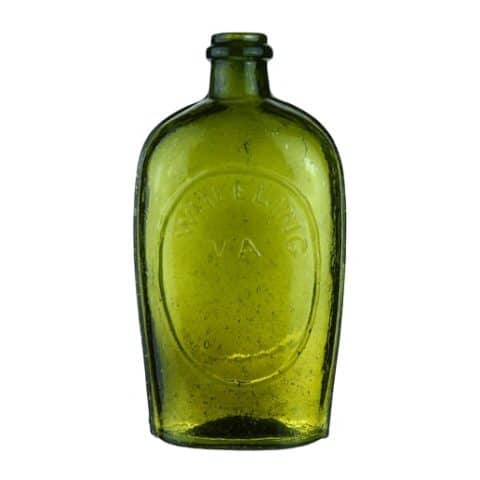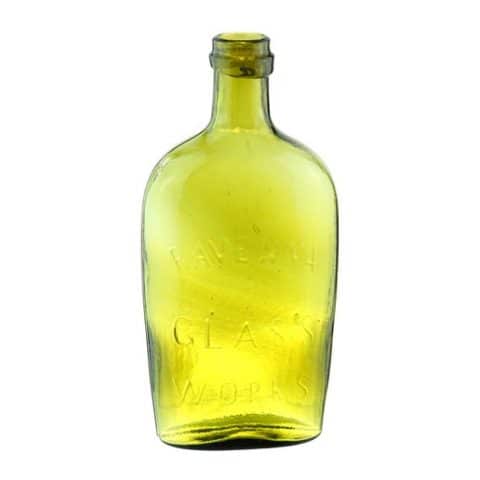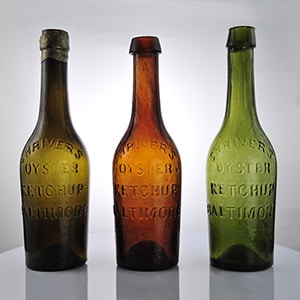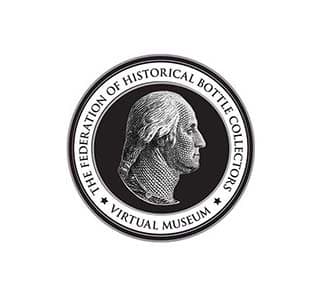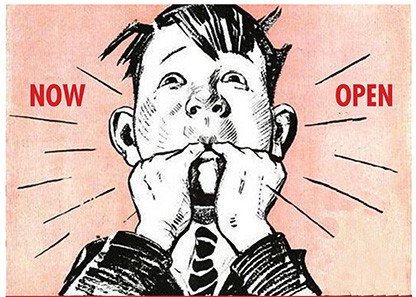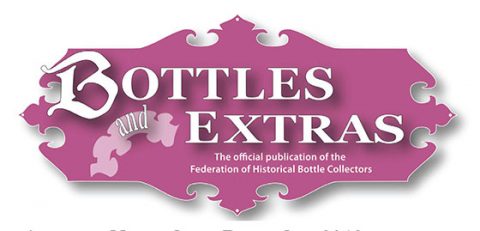GII – 57
Wide – Mouth
“J.P.F.” Eagle – Cornucopia “Conn.” Flask
GII – 57
“J.P.F.” Eagle – Cornucopia and “Conn.” Flask
Wide – Mouth
Attributed to Pitkin Glass Works
East Hartford, Connecticut
Olive Green Pint
Provenance: Anonymous
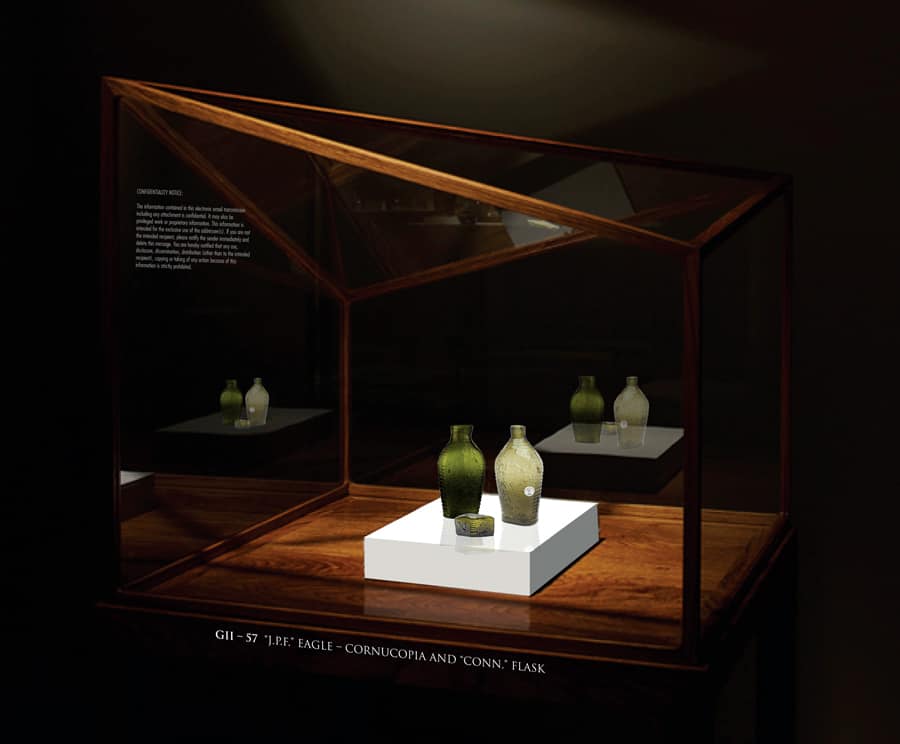
The GII-57 “J.P.F.” Eagle – Cornucopia and “Conn.” flask is a great rarity from an important Connecticut glasshouse. The flask is attributed to the Pitkin Glass Works from the Orford Parish of East Hartford, Connecticut. For most of its active existence, the Pitkin Glass Works was located in East Hartford until it became part of Manchester in 1823 when Manchester incorporated to become a separate town. The flask was made between 1815 and 1830.
Our museum example has a wide mouth, which is different than the drawing in American Bottles and Flasks and Their Ancestry which makes this flask one of a kind. The circa 1947 photograph below shows someone examining the same wide mouth “J.P.F.” Eagle – Cornucopia and “Conn” flask.
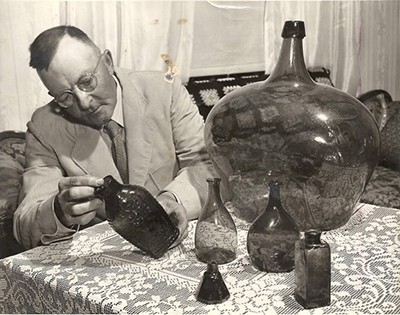
Early American glass authority Stephen Van Rensselaer believed that “J.P.F” stood for J. P. Foster who was associated with the Pitkin Glass Works. This is aligned with most present-day thinking. McKearin and Wilson note that the “J.P.F.” flask could have been a private mold, not a glassworks mold with the initials of the manager or lessee. The smaller GII-58 half-pint flask is a twin in design except for the absence of embossed lettering. See the museum example of a yellow-olive GII-58 Eagle – Cornucopia half-pint flask.
There is also an extremely rare and desirable “J.P.F.” inkwell that is attributed to Pitkin Glass Works. It is square with corrugated beveled corners. Each side depicts a different motif; “J.P.F.” or Eagle or Basket of Fruit or Geometric Motif. The inkwell is medium yellow olive, has a disc mouth and pontil scar. It is 1-3/8 inches tall by 2 ¼ inches and is pictured below. The ink now resides in the Manchester Historical Society where it was donated Marcie Dwyer from East Hartford. The inkwell is an ex VanWinkil collection and remains the only known example to this day.
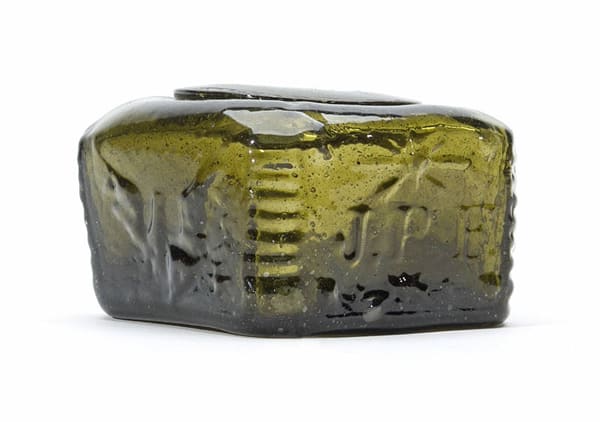
The obverse of the pint “J.P.F.” Eagle – Cornucopia and “Conn.” flask features an embossed American eagle with its head held erect and turned to the right. A shield with six verticle narrow bars is on the breast. The left wing is raised and foreshortened to give a three-dimensional appearance. Thirteen small five-pointed stars, four on the top and nine on the bottom are arranged in arcs above the eagle. Four arrows, also called thunderbolts, are in the eagle’s left talon and an olive branch is in the right talon. The eagle sits on an oval frame that contains the embossed initials “J. P. F.” Tassellike ornaments hang from the upper line of the frame. The lower part of the frame is extended and looped to form a medallion containing a square and compass and other ornamentation.
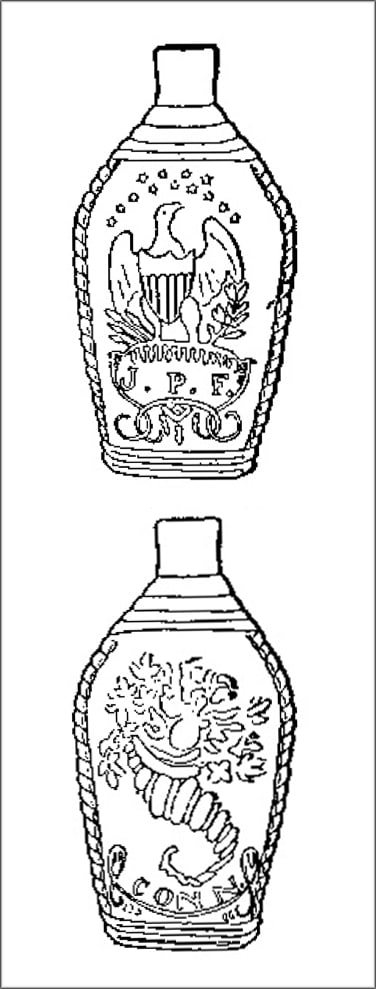
The reverse side of the flask pictures a large embossed cornucopia with the end coiled to the left. It is filled with produce. Below the cornucopia is an arched concave line with looped and scroll-ornamental ends. “CONN.” is embossed above the line. Beneath the line, at each end of the scroll, are two tiny ornaments.
The flask neck has four continuous horizontal ribs around the flask. The bottom of the flask has two continuous horizontal ribs that extend to both sides and the edges. The pint flask has a plain lip and pontil mark. The flask edges are corrugated horizontally with the corrugations extending around the flask at the base and juncture of the neck. Known colors are yellow-olive, olive amber, and olive green. Both are extremely rare. As noted previously, the wide-mouth example may be unique.
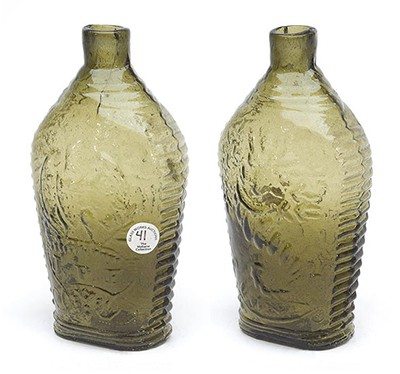
The Pitkin Glass Works 1783-1830
Connecticut’s first successful glassworks was known initially as the East Hartford Glass Works. It was formed by William Pitkin, his cousin Elisha Pitkin and Samuel Bishop in 1783 on the Pitkin farm. The trio was granted a 25-year exclusive privilege from the Connecticut General Assembly to manufacture all types of glass as recompense for their providing gun powder, at a loss, to the Connecticut militia during the American Revolutionary War. The Pitkin family was large, old, and influential and had many landholdings and business ties with glass, guns, gunpowder, textiles, flour, iron, silver, tobacco, and snuff.
Two names of former Pitkin superintendents and managers are Robert Hewes from the New England Glass Works in Temple, New Hampshire, and John P. Foster, whose initials are embossed and appear on an inkwell and the figured GII-57 “J.P.F.” Eagle – Cornucopia and “Conn” flask. The glassworks has always been considered a bottle glasshouse of which commercial products blown there consisted of chestnuts, demijohns for the West Indian trade, utilities, snuffs, globular bottles, and tableware like pitchers, creamers, bowls, and pans. The most popular and recognizable wares were the inkwells and molded flasks blown in the German half-post method consisting of ribs and swirls. The figured and sunburst flasks are all prized by collectors which include some extreme rarities. Window glass and clock faces were also manufactured at Pitkin in the early years.
Pitkin products were considered to be the best color and design in the country. The Pitkin glass colors are yellow-amber, olive-amber, olive-yellow, yellow-olive, olive-green, yellow-green, and a bluish to deep green. These are the New England “earthy” tones and were basically carried on in future Connecticut glasshouses.
Pitkin Glass Works remained in operation until about 1830 as they ran into financial difficulties. Several lotteries were held to raise additional funds, but the endeavor had to close.
The site containing the romantic ruins of the glassworks is owned and managed by Pitkin Glass Works Inc. and professional excavations are conducted there on a regular basis. Some examples of Pitkin glass are on display at the Old Manchester Museum in Manchester, Connecticut.
An article from the Manchester Historical Society’s website on the Pitkin Glassworks describes the glassworks as it exists today with links to an article on an archaeological excavation undertaken there in 2012.
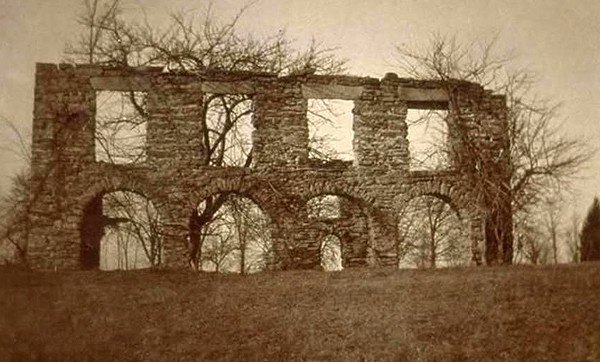
Primary Image: Example of the pint GII-57 imaged by the FOHBC Virtual Museum midwest studio by Alan DeMaison.
Support: Reference to The Museum of Connecticut Glass description of Pitkin Glass Works.
Support Secondary Images: Auction Lot 24: Eagle And “J.P.F” – Cornucopia And “CONN.” Historical Flask, Pitkin Glass Works, Manchester, Connecticut, 1815-1830. Yellow olive, sheared mouth – pontil scar, pint; (1 3/4 inch crack from the top of the mouth through the shoulder toward the eagle’s head, 3/8 inch potstone crack in the corrugated ribbing). GII-57. One of the great Connecticut rarities. Crude but beautiful. A marked example from a famous early glass house. Strongly embossed, beautiful light color, one of those gutsy, rare, early and unusual forms. Ex Robert Mebane collection, Warren “Bud” Lane collection. – Norman Heckler, Norman C. Heckler & Company, Auction 100, October 2012
Support Secondary Images: Auction Lot 67: “J.P.F.” Inkwell, probably Pitkin Glass Works, Manchester, Connecticut, 1815-1825. Square with corrugated beveled corners, each side depicting a different motif, “J.P.F.” / Eagle / Basket Of Fruit / Geometric Motif, medium yellow olive, disc mouth – pontil scar, ht. 1 3/8 inches, wdth. 2 1/4 inches; (3/16 inch bruise on edge of mouth). C #1111 and C #1112 Extremely rare and important, one of about five known examples. Generally fine condition. Ex William E. Covill Jr. collection, ex John Tiffany Gotjen collection, Alan Evanuk collection. – Norman Heckler, Norman C. Heckler & Company, Auction 167
Support Secondary Image: GII-57. Light olive amber glass; mold-blown; plain lip, pontil mark. Obverse: American Eagle, head held erect and turned to right; shield with six narrow bars on breast; wings partly raised. Thunderbolt (four arrows) in eagle’s right talons, large olive branch in left. Thirteen small five-pointed stars above eagle. Eagle stands on oval frame; tassel-like ornaments hang from upper line of frame, lower part of frame is extended and looped to form a medallion containing square and compasses and other ornamentation. Reverse: large cornucopia coiled to left and filled with produce. Beneath, curved line with looped and scroll ends. Beneath line at each end of the scroll are two tiny ornaments. Inscription: “J.P.F.” in oval frame beneath eagle; reverse – “CONN.” enclosed in scroll ends. Edges: corrugated horizontally, corrugations extend around flask at base and juncture of neck and body. Ex McKearin Antiques – Corning Museum of Glass
Support: Reference to American Bottles and Flasks and Their Ancestry by Helen McKearin and Kenneth M. Wilson, Crown Publishers Inc., New York, 1978.
Join the FOHBC: The Virtual Museum is a project of the Federation of Historical Bottle Collectors (FOHBC). To become a member.

